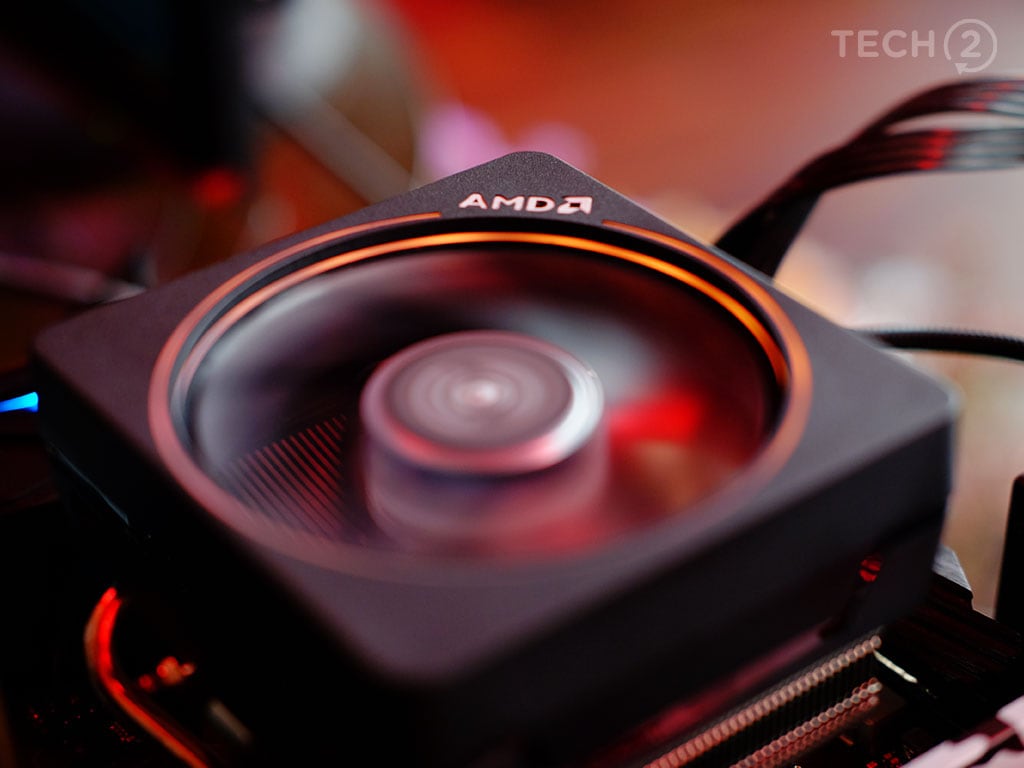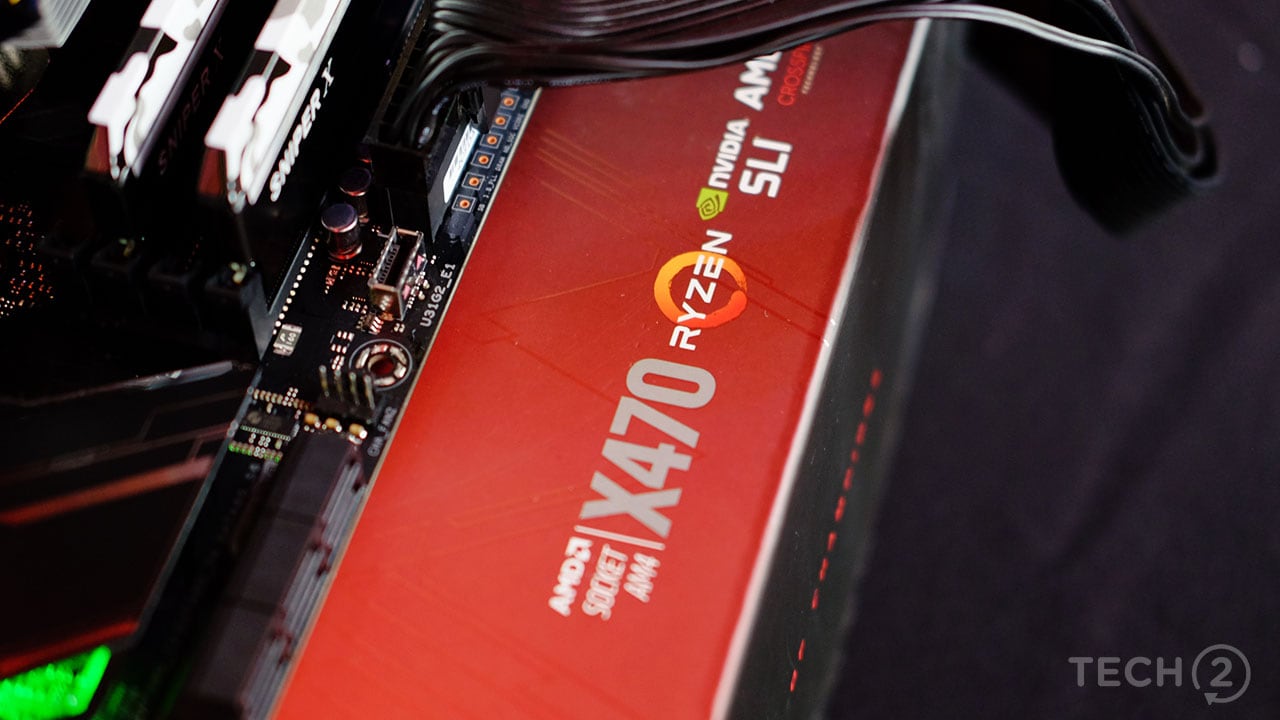Ever since I got my first PC, a Pentium II, I was hooked. Ripping apart PCs and putting them back together again was a hobby that I thought would never tire of. Sadly, this wasn’t to be.
Intel’s hegemony this past decade had gone unchallenged for so long that for years, there was nothing to look forward to. Don’t get me wrong, Intel’s done some incredible work with its chips, but year after year of incremental updates and insignificant performance bumps take their toll. Even Intel gave up expecting people to upgrade, instead focusing its energies on comparisons with five-year old hardware.
AMD, for whatever reason, simply failed to deliver a competitive high-end CPU for years. They hung on to the mid-range and low-end market for a while, but with a world turning increasingly to Intel’s chips, it just seemed like AMD would vanish into ignominy.

AMD Ryzen 2 CPUs come bundled with a new CPU cooler. Image: tech2/Anirudh Regidi
Last year, however, . AMD revealed Zen, an entirely new CPU architecture that came seemingly out of nowhere (if you ignore the 6-year development period). Suddenly, Intel was running scared — Intel’s amazing 8th gen CPUs were almost a knee-jerk reaction to AMD’s Ryzen CPUs, CPUs that suddenly represented incredible value to every segment of the market, CPUs that suddenly made one wonder at what Intel was subjecting us to for so many years.
To be fair to Intel, it’s not like AMD suddenly discovered some hidden truth of CPU design – Intel’s architectural efficiency is yet unmatched. On the other hand, it was Intel’s own complacency that allowed AMD to almost pull the proverbial rug out from under them.
In a quad-core world, AMD was offering 8-core chips. Where Intel’s top-of-the-line chips offered 18-cores for $2,000, AMD offered 16 for $1,000.
The key word here is “almost.” Ryzen was good, it was great, and it represented incredible value. The best thing that came out of Ryzen, however, was Intel’s 8th gen CPU. Intel was still ahead, but only in certain specific scenarios, and even then, by a hair’s breadth. And of course, the value-for-money factor was already heavily skewing in AMD’s favour.
Intel remains unmatched in the laptop space and it does seem like it’ll be quite a while before AMD catches up on that front.
Enter, Ryzen 2
Ryzen 2 is proof that Zen wasn’t a one-off. For AMD, this is a first of sorts.
Ryzen’s only real shortcoming was a lack of efficiency in comparison to Intel’s chips. Which is understandable, given that Intel has had years to refine and perfect its 14 nm chips while Ryzen was only AMD’s first generation Zen chip. Taking a page from Intel’s book, refining the architecture is what AMD spent its time on. The new architecture is called Zen+ and is virtually identical to Zen.
First, here’s what AMD’s second gen Ryzen line-up looks like right now:
| Ryzen 5 | Ryzen 7 | |||
| Model | 2600 | 2600X | 2700X | 2700 |
| Base Clock (GHz) | 3.4 | 3.6 | 3.7 | 3.2 |
| XFR (GHz) | 3.9 | 4.2 | 4.3 | 4.1 |
| Cores | 6 | 6 | 8 | 8 |
| Threads | 12 | 12 | 16 | 16 |
| TDP (W) | 65 | 95 | 105 | 65 |
| Price (USD) | 199 | 229 | 329 | 299 |
The model numbers conveniently align with Intel’s equivalent chips, with the 2700X competing against Intel’s 8700K, the 2600X against the 8600K, and so on.
India pricing is not aligned with US pricing, which will be cause for concern in the Indian market given that the R7 2700X is, in India, more expensive than Intel's competing i7 8700K.
Generational improvements
Versus previous gen Ryzen, the improvements are primarily two-fold. First, L1, L2 and L3 cache latency is vastly improved (up to 34 percent in the case of L2). Secondly, a new 12 nm process for the regular CPUs (not the APUs) also means that AMD could push the clock frequencies higher and reduce power consumption.
Together with the increased TDP (thermal design power), this leaves some promising headroom for overclocking.
X470 chipset
As far as motherboards are concerned, Ryzen 2 is compatible with the previous X370 chipsets and the new X470 ones. To take full advantage of Ryzen 2, you’ll need the X470 of course.

The new X470 chipsets are designed for Ryzen 2. Image: Anirudh Regidi/Tech2
Minor tweaks aside, the biggest advantage of using X470 is StoreMI (a.k.a. ), which is bundled free with X470 motherboards.
StoreMI is, quite simply, a program that leverages up to 2 GB of RAM and up to 128 GB of SSD storage to dramatically improve the overall performance of frequently used programs. StoreMI will adapt to your usage patterns in real-time, ensuring that storage is optimised for maximum performance. AMD claims that with StoreMI, applications can start up 9.8 times faster and load up programs much faster.
If you buy it separately (as FuzeDrive), it’s a $19.99 purchase. On the plus side, FuzeDrive is compatible with older 300 series chipsets. Better yet, you can opt for the $59.99 variant that supports 1 TB SSDs and up to 4 GB of RAM.
Precision Boost 2 and XFR2
With Ryzen 2, AMD is boosting core clock speeds in an entirely new way. Rather than boost performance in steps, determined by load and demand, Ryzen 2 will boost clock speeds dynamically based on the amount of power and thermal headroom available. Several other factors are involved, but the bottom line is that performance will be consistently better.

What's a CPU launch without an LN2 overclocking session? Image: Anirudh Regidi/Tech2
XFR2 (Extended Frequency Range 2) will now boost individual CPU cores beyond the limitations set by PB2 after factoring in load, temperature and other such factors. This will further boost overall performance.
Wraith coolers
Another major factor in AMD’s favour, and a big plus in my book, is the fact that AMD, unlike Intel, includes a $60 CPU cooler with the Ryzen 7 2700X. Intel offers nothing.
The bundled Wraith Prism cooler is quite capable, and in an overclocking showdown at the launch event, a Wraith-Prism toting rig took down some of the best liquid-cooled PCs in the competition. Better yet, the Wraith coolers with the Ryzen 7 chips support RGB lighting so that you don’t have to compromise on bling.
AMD vs Intel?
Here's what the those who have tested the second gen Ryzen CPUs have to say about them.
: “If you know you need single-threaded performance above everything else, the Core i7-8700K is still the top CPU on the market. But in well-threaded code, especially rendering applications, the Ryzen 7 2700X is superior. The fact that it’s $20 cheaper and ships with a decent stock cooler hurts nothing, either.”
“In the battle of Intel and AMD's flagship processors, the clear winner today is the Ryzen 7 2700X.”
“The AMD Ryzen 7 2700X fully outpaces the Intel Core i7-8700K, thanks to serious improvements made with Zen+ and higher clock speeds ending Team Blue’s frequency advantage.”
“Without a doubt, the 2700X gives AMD the chops to say, "Yeah, we got you beat, Intel." It is not beat by miles, but AMD is standing toe to toe with Intel on the desktop and getting in more punches.”
Has AMD actually defeated Intel? At long last, it certainly seems so. Going through the reviews, it's quite clear that AMD’s line-up is cheaper, offers better multi-threaded performance, comparable gaming performance and comes bundled with better CPU coolers.
Intel’s hegemony is at an end, PCs are fun again. What more could anyone ask for?
Updated Date: May 01, 2018 08:45 AM